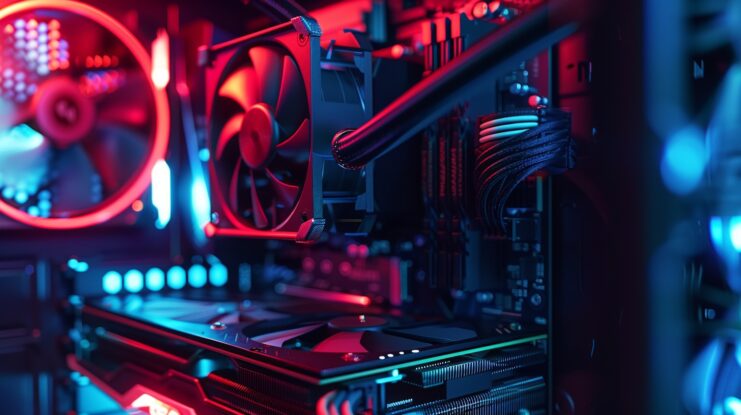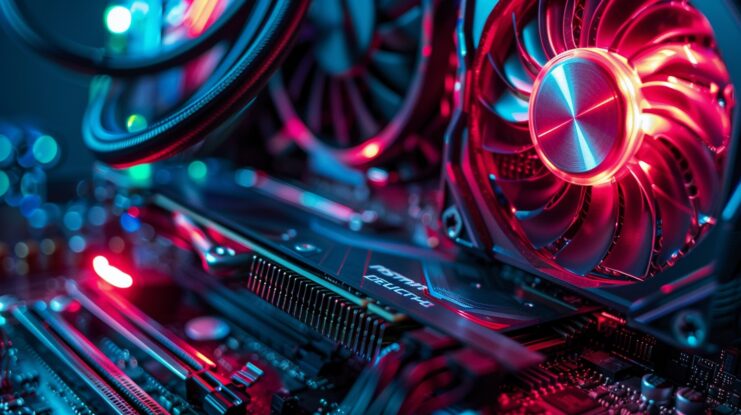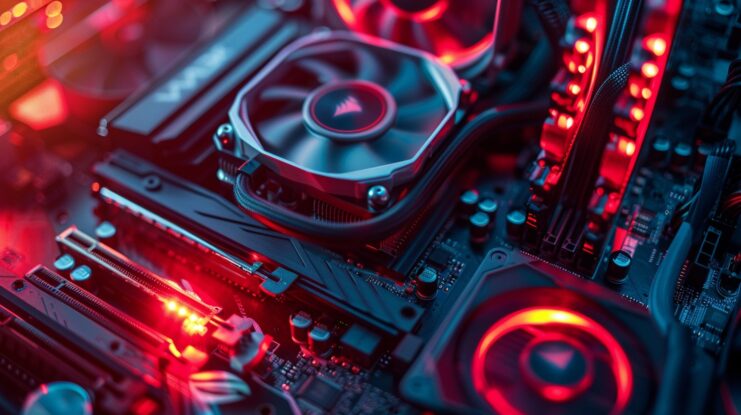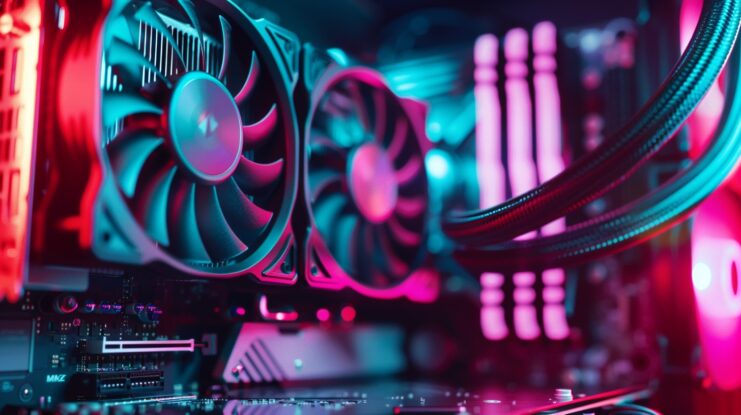As an avid gamer or someone who frequently uses high-powered computer programs, I’ve learned that the temperature of my graphics card—the component that brings my games to life—is crucial. If it overheats, not only can it throttle the performance of my games, but it can also pose a risk to my computer’s overall health.
So, what is the ideal temperature to maintain? I’ve put together this guide to help you, and myself, find that optimal temperature range where our graphics cards can perform at their best without the risk of overheating. I’ll cover the safe temperature range for GPUs to ensure our hardware remains protected.
I’ll also share some tips on how to maintain a cool system, allowing us to enjoy uninterrupted gaming sessions and keep our computers running efficiently.
Without further ado, let us begin.
Key Takeaway:
- The safe GPU temperature range during gaming is between 60 to 85 degrees Celsius.
- Effective cooling systems are essential for maintaining these optimal temperature ranges.
- A well-ventilated case and regular cleaning to remove dust are vital for efficient cooling.
Safe GPU Temperature Range for Gaming
The temperature of your GPU (Graphics Processing Unit) is a critical factor that can significantly affect performance and longevity. A safe and optimal GPU temperature range during gaming sessions is typically between 60 to 85 degrees Celsius (140 – 185 degrees Fahrenheit).
Staying within this range ensures that your gaming experience is smooth, without any stuttering performance or game crashes that can occur due to overheating.
| Temperature Range (°C) | Temperature Range (°F) | Status |
|---|---|---|
| Below 60 | Below 140 | Underutilized/Very Cool |
| 60 – 85 | 140 – 185 | Safe/Optimal for Gaming |
| Above 85 | Above 185 | Risky/Overheating |
Modern GPUs are designed with built-in mechanisms to protect against damage from overheating. When a GPU’s temperature reaches a high level, it will automatically throttle itself, reducing its frequency and performance to cool down.
While this protective measure prevents hardware damage, it’s a clear sign that cooling improvements are necessary to maintain optimal performance.
Importance of Cooling Systems

The importance of cooling systems in maintaining optimal GPU temperatures cannot be overstated. These systems are crucial for keeping temperatures within safe limits, thereby ensuring that your GPU performs efficiently during gaming sessions or intensive computational tasks.
Cooling systems come in various forms, including fans, heatsinks, and, for those who require peak performance from their setups, liquid cooling systems.
Fans and Heatsinks
These are the most common cooling solutions found in both desktops and laptops. Fans help in moving hot air away from the GPU and other components, while heatsinks absorb and dissipate the heat. The effectiveness of these systems largely depends on the quality of the components and the overall airflow within the case.
Liquid Cooling Systems
For enthusiasts and those pushing their systems with overclocking, liquid cooling offers a more efficient heat transfer than air cooling. By circulating a coolant through a loop that includes a block attached to the GPU, heat is more effectively removed from the component and dissipated through a radiator.
This system can significantly lower temperatures, allowing for higher overclocking thresholds and potentially longer hardware lifespan.
Ventilation and Maintenance
For desktop PCs, the design of the case and its ventilation capabilities play a significant role in cooling efficiency. A well-ventilated case with strategically placed fans can greatly enhance airflow, reducing hotspots and preventing heat accumulation.
Regular maintenance, such as cleaning dust from fans and heatsinks, is also vital to maintain optimal cooling performance. Dust accumulation can insulate heat, reducing the efficiency of cooling components.
Laptop Cooling Considerations
Gaming laptops, known for their compact designs, face unique cooling challenges. The use of a sturdy metal stand can significantly improve heat dissipation, particularly for models that expel heat from bottom vents. Some stands are designed with built-in fans to further aid in cooling, offering an additional layer of temperature management for intensive gaming sessions.
Monitoring and Maintenance

Monitoring and maintenance play a pivotal role in the health and performance of your GPU, especially during intensive tasks such as gaming or graphic design work. Regularly keeping an eye on your GPU’s temperature helps in preemptively identifying potential overheating issues, which can lead to throttling or even permanent damage if left unchecked.
Simple Monitoring Tools
For many users, the Windows Task Manager offers a straightforward method to check their GPU’s temperature. Available in Windows 10 and 11, this feature allows users to quickly view their GPU’s current temperature without the need for additional software. This can be particularly useful for a quick check, but it might not provide the depth of data required for a thorough analysis.
Advanced Monitoring Tools
For those who need more detailed information about their GPU’s performance, third-party applications like MSI Afterburner are invaluable. These tools offer real-time monitoring of not just the GPU temperature, but also fan speeds, clock speeds, and voltage levels.
Detailed data allows users to make informed decisions about their system’s cooling needs and performance adjustments. Furthermore, MSI Afterburner and similar applications often include features for custom fan curve adjustments, enabling users to optimize their cooling based on specific temperature thresholds.
Setting Up Alerts
Some monitoring tools offer the capability to set temperature alerts, notifying you when your GPU exceeds safe operating temperatures. This feature can be particularly useful during long gaming sessions or overnight tasks, providing an opportunity to address overheating issues before they cause system instability or damage.
NVIDIA and AMD GPU Temperature Limits

NVIDIA and AMD, as leading manufacturers in the GPU market, design their products to withstand high temperatures, especially under heavy loads such as gaming, rendering, and other intensive computational tasks. The maximum temperature limits can vary significantly between different models, reflecting differences in architecture, cooling solutions, and intended use cases.
| GPU Model | Manufacturer | Max Temperature Limit (°C) | Max Temperature Limit (°F) |
|---|---|---|---|
| GeForce RTX 4090 | NVIDIA | 90 | 194 |
| Radeon RX 7900 XTX | AMD | 110 | 230 |
While these GPUs are built to operate safely within these temperature ranges, it is generally advisable to maintain operating temperatures well below these maximum limits. Doing so not only ensures the longevity of the GPU but also contributes to more stable performance, as high temperatures can lead to thermal throttling, where the GPU reduces its clock speed to lower its temperature, impacting performance.
FAQs
Should I put fans under my GPU?
Yes, adding fans under your GPU can help improve airflow and cooling, especially in high-performance or gaming setups. This can lead to lower temperatures and better performance.
Do GPUs need heatsink?
Yes, GPUs need a heatsink to dissipate heat effectively. The heatsink absorbs heat from the GPU and helps keep it cool, preventing overheating and potential damage.
How to check GPU health?
To check your GPU’s health, you can use software tools like GPU-Z or MSI Afterburner. These programs provide information on temperature, usage, and performance, helping you monitor the health and efficiency of your GPU.
Is 30% GPU usage bad?
No, 30% GPU usage is not necessarily bad. It depends on what tasks you’re performing. For light tasks or idle periods, lower GPU usage is normal. For more demanding activities like gaming or video editing, higher usage is expected for optimal performance.
The Bottom Line
Maintaining a safe GPU temperature is vital for the optimal performance and longevity of your gaming PC or laptop. By understanding the safe temperature ranges, implementing effective cooling solutions, and regularly monitoring temperatures, gamers can enjoy a smooth and stable gaming experience.
Remember, the cooler your GPU runs, the better it performs, making cooling systems and regular maintenance key components of any gaming setup.

